Search results for: 'Compa'
- Related search terms
- compactor
- Compact
- Compacto
- Compactor+open+w
- compa'[0]
-
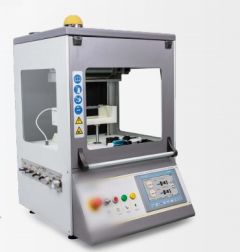 ADVANCED LEVEL SINGLE NOZZLE ELECTROSPINNING UNIT - DRUM COLLECTORREFERENCE NUMBER: A-2477 ADVANCED LEVEL SINGLE NOZZLE ELECTROSPINNING UNIT - DRUM COLLECTOR MACHINE IS A LABORATORY SCALE ELECTROSPINNING UNIT WITH A SINGLE NOZZLE. THE STANDARD MACHINES HAVE A 500 RPM ROTATING DRUM COLLECTOR AND A FLAT COLLECTOR. THERE ARE OPTIONAL ACCESSORIES UPON REQUEST FOR FUNCTIONALITY IMPROVEMENT. OPERATION PARAMETERS LIKE THE NEEDLE-COLLECTOR DISTANCE AND HIGH VOLTAGE VALUE COULD BE AUTOMATICALLY ADJUSTED FROM THE USER PANEL, WITH HIGH PRECISION. THE SYSTEM COMES WITH AN ENCLOSED CABINET MAKING IT POSSIBLE TO ADD TEMPERATURE AND RELATIVE HUMIDITY CONTROL SYSTEMS. SPECIFICATIONS: SPINNING-TYPE: BOTTOM-UP SPINNING CHASSIS: ELECTROSTATICALLY PAINTED STEEL FEEDING AREA MATERIAL: PE 1000 (HIGH DENSITY, CHEMICAL RESISTANT) COLLECTOR MATERIAL: 7000 SERIES ALUMINUM ALLOY, STAINLESS STEEL LED ILLUMINATION EXHAUST FAN ATMOSPHERE CONTROL (OPTIONAL) TOTAL WEIGHT: APPROX.150 KGS DIMENSIONS: 770 X 675 X 1040 mm HIGH VOLTAGE POWER SUPPLY VOLTAGE RANGE: 0 TO 40 KV VOLTAGE PRECISION: 0.1 KV MAX CURRENT: 0.125 MA HIGH PRECISION MICRO PUMP FLOW RATE: 0.01 TO 4464 ML/H (BD 60 ML SYRINGE) FLOW RATE PRECISION: 0.01 ML/H AVAILABLE SYRINGES STANDARD: ALL TYPES ARE AVAILABLE FEEDING AREA NUMBER OF NOZZLES: 1 NOZZLE NOZZLE MATERIAL: ELECTRICALLY CONDUCTIVE STAINLESS STEEL NOZZLE INNER DIAMETER: 0.8 mm COMPATIBLE WITH STANDARD SYRINGE NOZZLES MINIMUM REQUIRED SOLUTION FOR SINGLE NOZZLE FEEDING: 2 ML SPINNING DISTANCE DISTANCE BETWEEN NOZZLE AND COLLECTOR: 33.5 TO 233.5 mm DISTANCE ADJUSTMENT PRECISION: 1 mm ROTATING COLLECTOR DRUM COLLECTOR MATERIAL: ALUMINUM DIMENSIONS OF DRUM: 100 X 150 mm FIBER DEPOSITION AREA: 314 X 150 mm DRUM ROTATING SPEED: 100 TO 500 RPM SURFACE SPEED: 52.3 CM/S TO 261.6 CM/S STATIONARY PLATE COLLECTOR MATERIAL: STAINLESS STEEL DIMENSIONS OF STATIONARY PLATE: 370 X 130 mm UNIQUE USER INTERFACE 9" TOUCH SCREEN CONTROL PANEL WITH WELL DESIGNED USER FRIENDLY INTERFACE FULLY ABLE TO CONTROL ALL PARAMETERS SAVING & RECALLING ALL PARAMETERS VIA RECIPE & RECALL FUNCTION SAFETY FUNCTION SAFE DOOR EMERGENCY BUTTON & SAFETY RELAY HV WARNING LIGHT ELECTRICAL ISOLATED & GROUNDED CABINET OVER CURRENT PROTECTION FULLY SEALED CABINET TECHNICAL REQUIREMENTS POWER: 220 VOLTS AND 50/60 HZ @ MAX 25A GROUNDING: EXTERNAL GROUNDING LINE AREA: MIN. 1000 X 1000 mm WORKBENCH ABLE TO CARRY MINIMUM 150 KGS. Learn More
ADVANCED LEVEL SINGLE NOZZLE ELECTROSPINNING UNIT - DRUM COLLECTORREFERENCE NUMBER: A-2477 ADVANCED LEVEL SINGLE NOZZLE ELECTROSPINNING UNIT - DRUM COLLECTOR MACHINE IS A LABORATORY SCALE ELECTROSPINNING UNIT WITH A SINGLE NOZZLE. THE STANDARD MACHINES HAVE A 500 RPM ROTATING DRUM COLLECTOR AND A FLAT COLLECTOR. THERE ARE OPTIONAL ACCESSORIES UPON REQUEST FOR FUNCTIONALITY IMPROVEMENT. OPERATION PARAMETERS LIKE THE NEEDLE-COLLECTOR DISTANCE AND HIGH VOLTAGE VALUE COULD BE AUTOMATICALLY ADJUSTED FROM THE USER PANEL, WITH HIGH PRECISION. THE SYSTEM COMES WITH AN ENCLOSED CABINET MAKING IT POSSIBLE TO ADD TEMPERATURE AND RELATIVE HUMIDITY CONTROL SYSTEMS. SPECIFICATIONS: SPINNING-TYPE: BOTTOM-UP SPINNING CHASSIS: ELECTROSTATICALLY PAINTED STEEL FEEDING AREA MATERIAL: PE 1000 (HIGH DENSITY, CHEMICAL RESISTANT) COLLECTOR MATERIAL: 7000 SERIES ALUMINUM ALLOY, STAINLESS STEEL LED ILLUMINATION EXHAUST FAN ATMOSPHERE CONTROL (OPTIONAL) TOTAL WEIGHT: APPROX.150 KGS DIMENSIONS: 770 X 675 X 1040 mm HIGH VOLTAGE POWER SUPPLY VOLTAGE RANGE: 0 TO 40 KV VOLTAGE PRECISION: 0.1 KV MAX CURRENT: 0.125 MA HIGH PRECISION MICRO PUMP FLOW RATE: 0.01 TO 4464 ML/H (BD 60 ML SYRINGE) FLOW RATE PRECISION: 0.01 ML/H AVAILABLE SYRINGES STANDARD: ALL TYPES ARE AVAILABLE FEEDING AREA NUMBER OF NOZZLES: 1 NOZZLE NOZZLE MATERIAL: ELECTRICALLY CONDUCTIVE STAINLESS STEEL NOZZLE INNER DIAMETER: 0.8 mm COMPATIBLE WITH STANDARD SYRINGE NOZZLES MINIMUM REQUIRED SOLUTION FOR SINGLE NOZZLE FEEDING: 2 ML SPINNING DISTANCE DISTANCE BETWEEN NOZZLE AND COLLECTOR: 33.5 TO 233.5 mm DISTANCE ADJUSTMENT PRECISION: 1 mm ROTATING COLLECTOR DRUM COLLECTOR MATERIAL: ALUMINUM DIMENSIONS OF DRUM: 100 X 150 mm FIBER DEPOSITION AREA: 314 X 150 mm DRUM ROTATING SPEED: 100 TO 500 RPM SURFACE SPEED: 52.3 CM/S TO 261.6 CM/S STATIONARY PLATE COLLECTOR MATERIAL: STAINLESS STEEL DIMENSIONS OF STATIONARY PLATE: 370 X 130 mm UNIQUE USER INTERFACE 9" TOUCH SCREEN CONTROL PANEL WITH WELL DESIGNED USER FRIENDLY INTERFACE FULLY ABLE TO CONTROL ALL PARAMETERS SAVING & RECALLING ALL PARAMETERS VIA RECIPE & RECALL FUNCTION SAFETY FUNCTION SAFE DOOR EMERGENCY BUTTON & SAFETY RELAY HV WARNING LIGHT ELECTRICAL ISOLATED & GROUNDED CABINET OVER CURRENT PROTECTION FULLY SEALED CABINET TECHNICAL REQUIREMENTS POWER: 220 VOLTS AND 50/60 HZ @ MAX 25A GROUNDING: EXTERNAL GROUNDING LINE AREA: MIN. 1000 X 1000 mm WORKBENCH ABLE TO CARRY MINIMUM 150 KGS. Learn More -
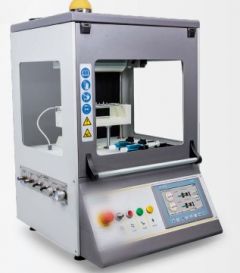 ADVANCED LEVEL MULTI NOZZLE ELECTROSPINNING UNIT - 8 NOZZLESREFERENCE NUMBER: A-2476 ADVANCED LEVEL MULTI NOZZLE ELECTROSPINNING UNIT - 8 NOZZLES FULLY AUTOMATED ELECTROSPINNING MACHINE IS DESIGNED TO CARRY ELECTROSPINNING RESEARCH TO A MORE ADVANCED LEVEL. MACHINE IS A HYBRID ELECTROSPINNING SYSTEM OF EIGHT NEEDLES. IT HAS A 314 X 220 mm NANOFIBER COATING AREA VIA A ROTATING DRUM COLLECTOR, ALSO A FLAT COLLECTOR OF 130 X 370 mm COMES WITH THE STANDARD CONFIGURATION. THE NE 300 HAS AN ELECTRICALLY INSULATED CABINET WITH HIGH DENSITY PE PARTS INERT TO CHEMICAL SOLUTIONS, WHICH ENABLES WORKING WITH MANY DIFFERENT SOLVENTS AND POLYMERS. SPECIFICATIONS: SPINNING-TYPE: BOTTOM-UP SPINNING CHASSIS: ELECTROSTATICALLY PAINTED STEEL FEEDING AREA MATERIAL: PE 1000 (HIGH DENSITY, CHEMICAL RESISTANT) COLLECTOR MATERIAL: 7000 SERIES ALUMINUM ALLOY, STAINLESS STEEL LED ILLUMINATION EXHAUST FAN ATMOSPHERE CONTROL (OPTIONAL) TOTAL WEIGHT: APPROX.150 KGS DIMENSIONS: 770 X 675 X 1040 mm HIGH VOLTAGE POWER SUPPLY VOLTAGE RANGE: 0 TO 40 KV VOLTAGE PRECISION: 0.1 KV MAX CURRENT: 0.125 MA HIGH PRECISION MICRO PUMP FLOW RATE: 0.01 TO 4464 ML/H (BD 60 ML SYRINGE) FLOW RATE PRECISION: 0.01 ML/H AVAILABLE SYRINGES STANDARD: ALL TYPES ARE AVAILABLE FEEDING AREA NUMBER OF NOZZLES ON EACH FEEDING PIPE SET: 4 PCS NUMBER OF FEEDING PIPE SETS: UP TO 2 SETS NUMBER OF NOZZLES: UP TO 8 NOZZLES SINGLE NOZZLE PRODUCTION: AVAILABLE FEEDING PIPE MATERIAL: ALUMINUM NOZZLE MATERIAL: ELECTRICALLY CONDUCTIVE STAINLESS STEEL NOZZLE INNER DIAMETER: 0.8 mm COMPATIBLE WITH STANDARD SYRNIGE NOZZLES MINIMUM REQUIRED SOLUTION FOR SINGLE NOZZLE FEEDING: 1 ML MINIMUM REQUIRED SOLUTION FOR EACH FEEDING PIPE SET: 8.5 ML MINIMUM REQUIRED SOLUTION FOR FULL LOADING: 16 ML SPINNING DISTANCE DISTANCE BETWEEN NOZZLE AND COLLECTOR: 33.5 TO 233.5 mm DISTANCE ADJUSTMENT PRECISION: 1 mm ROTATING COLLECTOR DRUM COLLECTOR MATERIAL: ALUMINUM DIMENSIONS OF DRUM: 100 X 220 mm FIBER DEPOSITION AREA: 314 X 220 mm DRUM ROTATING SPEED: 100 TO 500 RPM SURFACE SPEED: 52.3 CM/S TO 261.6 CM/S COATING HOMOGENEITY SYSTEM: X-AXIS REPETITIVE MOTION STROKE OF COATING HOMOGENEITY SYSTEM: 30 TO 80 mm SPEED OF COATING HOMOGENEITY SYSTEM: 2 TO 20 mm /SEC STATIONARY PLATE COLLECTOR MATERIAL: STAINLESS STEEL DIMENSIONS OF STATIONARY PLATE: 370 X 130 mm UNIQUE USER INTERFACE 9" TOUCH SCREEN CONTROL PANEL WITH WELL DESIGNED USER FRIENDLY INTERFACE FULLY ABLE TO CONTROL ALL PARAMETERS SAVING & RECALLING ALL PARAMETERS VIA RECIPE & RECALL FUNCTION SAFETY FUNCTION SAFE DOOR EMERGENCY BUTTON & SAFETY RELAY HV WARNING LIGHT ELECTRICAL ISOLATED & GROUNDED CABINET OVER CURRENT PROTECTION FULLY SEALED CABINET TECHNICAL REQUIREMENTS POWER: 220 VOLTS AND 50/60 HZ @ MAX 25A GROUNDING: EXTERNAL GROUNDING LINE AREA: MIN. 1000 X 1000 mm WORKBENCH ABLE TO CARRY MINIMUM 150 KGS. Learn More
ADVANCED LEVEL MULTI NOZZLE ELECTROSPINNING UNIT - 8 NOZZLESREFERENCE NUMBER: A-2476 ADVANCED LEVEL MULTI NOZZLE ELECTROSPINNING UNIT - 8 NOZZLES FULLY AUTOMATED ELECTROSPINNING MACHINE IS DESIGNED TO CARRY ELECTROSPINNING RESEARCH TO A MORE ADVANCED LEVEL. MACHINE IS A HYBRID ELECTROSPINNING SYSTEM OF EIGHT NEEDLES. IT HAS A 314 X 220 mm NANOFIBER COATING AREA VIA A ROTATING DRUM COLLECTOR, ALSO A FLAT COLLECTOR OF 130 X 370 mm COMES WITH THE STANDARD CONFIGURATION. THE NE 300 HAS AN ELECTRICALLY INSULATED CABINET WITH HIGH DENSITY PE PARTS INERT TO CHEMICAL SOLUTIONS, WHICH ENABLES WORKING WITH MANY DIFFERENT SOLVENTS AND POLYMERS. SPECIFICATIONS: SPINNING-TYPE: BOTTOM-UP SPINNING CHASSIS: ELECTROSTATICALLY PAINTED STEEL FEEDING AREA MATERIAL: PE 1000 (HIGH DENSITY, CHEMICAL RESISTANT) COLLECTOR MATERIAL: 7000 SERIES ALUMINUM ALLOY, STAINLESS STEEL LED ILLUMINATION EXHAUST FAN ATMOSPHERE CONTROL (OPTIONAL) TOTAL WEIGHT: APPROX.150 KGS DIMENSIONS: 770 X 675 X 1040 mm HIGH VOLTAGE POWER SUPPLY VOLTAGE RANGE: 0 TO 40 KV VOLTAGE PRECISION: 0.1 KV MAX CURRENT: 0.125 MA HIGH PRECISION MICRO PUMP FLOW RATE: 0.01 TO 4464 ML/H (BD 60 ML SYRINGE) FLOW RATE PRECISION: 0.01 ML/H AVAILABLE SYRINGES STANDARD: ALL TYPES ARE AVAILABLE FEEDING AREA NUMBER OF NOZZLES ON EACH FEEDING PIPE SET: 4 PCS NUMBER OF FEEDING PIPE SETS: UP TO 2 SETS NUMBER OF NOZZLES: UP TO 8 NOZZLES SINGLE NOZZLE PRODUCTION: AVAILABLE FEEDING PIPE MATERIAL: ALUMINUM NOZZLE MATERIAL: ELECTRICALLY CONDUCTIVE STAINLESS STEEL NOZZLE INNER DIAMETER: 0.8 mm COMPATIBLE WITH STANDARD SYRNIGE NOZZLES MINIMUM REQUIRED SOLUTION FOR SINGLE NOZZLE FEEDING: 1 ML MINIMUM REQUIRED SOLUTION FOR EACH FEEDING PIPE SET: 8.5 ML MINIMUM REQUIRED SOLUTION FOR FULL LOADING: 16 ML SPINNING DISTANCE DISTANCE BETWEEN NOZZLE AND COLLECTOR: 33.5 TO 233.5 mm DISTANCE ADJUSTMENT PRECISION: 1 mm ROTATING COLLECTOR DRUM COLLECTOR MATERIAL: ALUMINUM DIMENSIONS OF DRUM: 100 X 220 mm FIBER DEPOSITION AREA: 314 X 220 mm DRUM ROTATING SPEED: 100 TO 500 RPM SURFACE SPEED: 52.3 CM/S TO 261.6 CM/S COATING HOMOGENEITY SYSTEM: X-AXIS REPETITIVE MOTION STROKE OF COATING HOMOGENEITY SYSTEM: 30 TO 80 mm SPEED OF COATING HOMOGENEITY SYSTEM: 2 TO 20 mm /SEC STATIONARY PLATE COLLECTOR MATERIAL: STAINLESS STEEL DIMENSIONS OF STATIONARY PLATE: 370 X 130 mm UNIQUE USER INTERFACE 9" TOUCH SCREEN CONTROL PANEL WITH WELL DESIGNED USER FRIENDLY INTERFACE FULLY ABLE TO CONTROL ALL PARAMETERS SAVING & RECALLING ALL PARAMETERS VIA RECIPE & RECALL FUNCTION SAFETY FUNCTION SAFE DOOR EMERGENCY BUTTON & SAFETY RELAY HV WARNING LIGHT ELECTRICAL ISOLATED & GROUNDED CABINET OVER CURRENT PROTECTION FULLY SEALED CABINET TECHNICAL REQUIREMENTS POWER: 220 VOLTS AND 50/60 HZ @ MAX 25A GROUNDING: EXTERNAL GROUNDING LINE AREA: MIN. 1000 X 1000 mm WORKBENCH ABLE TO CARRY MINIMUM 150 KGS. Learn More -
 SEMI INDUSTRIAL SCALE MULTI NOZZLE ELECTROSPINNING UNIT - 18 NOZZLESREFERENCE NUMBER: A-2474 SEMI INDUSTRIAL SCALE MULTI NOZZLE ELECTROSPINNING UNIT - 18 NOZZLES MACHINE IS A COMPACT CONTINUOUS NANOFIBER PRODUCTION MACHINE. ITS MAJOR ADVANTAGE IS SCALABILITY, AS IT’S SUITABLE FOR BOTH PRODUCTION LINE AS WELL AS R&D PROJECTS. IT FUNCTIONS WITH 18 NOZZLES ENABLING HIGH PRODUCTIVITY FOR MASS PRODUCTION OF NANOFIBERS, HOWEVER IT CAN ALSO FUNCTION WITH SINGLE NOZZLE THEREFORE ENABLES WORKING ON SMALL-SCALE R&D PROJECTS. ITS UNIQUE DESIGN ENABLES PRODUCTION OF NANOFIBERS AND COMPOSITES, IT ACCOMMODATES TWO SYRINGE PUMPS AND TWO HIGH VOLTAGE POWER SUPPLIERS, MAKING IT POSSIBLE TO WORK SIMULTANEOUSLY WITH UP TO TWO DIFFERENT POLYMERS, INDEPENDENTLY CONTROLLABLE SPECIFICATIONS: SPINNING-TYPE: BOTTOM-UP SPINNING CHASSIS: ELECTROSTATIC PAINTED SHEET METAL FEEDING AREA MATERIAL: PE 1000 (HIGH DENSITY, CHEMICAL RESISTANT) COLLECTOR MATERIAL: STAINLESS STEEL LED ILLUMINATION EXHAUST FAN ATMOSPHERE CONTROL (OPTIONAL) TOTAL WEIGHT: APPROX. 350 KGS DIMENSIONS: 1585 X 1550 X 1950 mm HIGH VOLTAGE POWER SUPPLY NUMBER OF HV GENERATORS: 2 UNITS (1 FOR EACH SOLUTION FEEDING ROD) VOLTAGE RANGE: 0 TO 40 KV VOLTAGE PRECISION: 0.1 KV MAX CURRENT: 0.125 MA HIGH PRECISION MICRO PUMP NUMBER OF PUMPS: 2 UNITS FLOW RATE: 0.01 TO 4464 ML/H (BD 60 ML SYRINGE) FLOW RATE PRECISION: 0.01 ML AVAILABLE SYRINGES: ALL TYPES ARE AVAILABLE FEEDING AREA NUMBER OF NOZZLES ON EACH FEEDING PIPE SET: 9 PCS NUMBER OF FEEDING PIPE SETS: 2 PCS NUMBER OF NOZZLES: 18 PCS SINGLE NOZZLE PRODUCTION: AVAILABLE FEEDING PIPE MATERIAL: ALUMINUM NOZZLE MATERIAL: ELECTRICALLY CONDUCTIVE STAINLESS STEEL NOZZLE INNER DIAMETER: 0.8 mm MINIMUM REQUIRED SOLUTION FOR SINGLE NOZZLE FEEDING: 2 ML MINIMUM REQUIRED SOLUTION FOR EACH FEEDING PIPE SET: 8 ML MINIMUM REQUIRED SOLUTION FOR FULL LOADING: 18 ML SPINNING DISTANCE DISTANCE BETWEEN NOZZLE AND COLLECTOR: 30 TO 280 mm DISTANCE ADJUSTMENT PRECISION: 1 mm COLLECTOR ROLL TO ROLL COLLECTOR FIBER DEPOSITION WIDTH: 300 mm SUBSTRATE WINDING SPEED: 0,01 M/MIN TO 1 M/min REPETITIVE WINDING MODE (OPTIONAL) COATING HOMOGENEITY SYSTEM: X-AXIS REPETITIVE MOTION STROKE OF COATING HOMOGENEITY SYSTEM: 10 MM TO 80 mm SPEED OF COATING HOMOGENEITY SYSTEM: 2 TO 20 mm/SEC UNIQUE USER INTERFACE 9" TOUCH SCREEN CONTROL PANEL WITH WELL DESIGNED USER FRIENDLY INTERFACE FULLY ABLE TO CONTROL ALL PARAMETERS SAVING & RECALLING ALL PARAMETERS VIA RECIPE & RECALL FUNCTION SAFETY FUNCTION SAFE DOOR EMERGENCY BUTTON & SAFETY RELAY HV WARNING LIGHT ELECTRICAL ISOLATED & GROUNDED CABINET OVER CURRENT PROTECTION TECHNICAL REQUIREMENTS POWER: 220 VOLTS AND 50/60 HZ @ MAX 25A GROUNDING: EXTERNAL GROUNDING LINE AREA: MIN. 2000 X 2000 mm Learn More
SEMI INDUSTRIAL SCALE MULTI NOZZLE ELECTROSPINNING UNIT - 18 NOZZLESREFERENCE NUMBER: A-2474 SEMI INDUSTRIAL SCALE MULTI NOZZLE ELECTROSPINNING UNIT - 18 NOZZLES MACHINE IS A COMPACT CONTINUOUS NANOFIBER PRODUCTION MACHINE. ITS MAJOR ADVANTAGE IS SCALABILITY, AS IT’S SUITABLE FOR BOTH PRODUCTION LINE AS WELL AS R&D PROJECTS. IT FUNCTIONS WITH 18 NOZZLES ENABLING HIGH PRODUCTIVITY FOR MASS PRODUCTION OF NANOFIBERS, HOWEVER IT CAN ALSO FUNCTION WITH SINGLE NOZZLE THEREFORE ENABLES WORKING ON SMALL-SCALE R&D PROJECTS. ITS UNIQUE DESIGN ENABLES PRODUCTION OF NANOFIBERS AND COMPOSITES, IT ACCOMMODATES TWO SYRINGE PUMPS AND TWO HIGH VOLTAGE POWER SUPPLIERS, MAKING IT POSSIBLE TO WORK SIMULTANEOUSLY WITH UP TO TWO DIFFERENT POLYMERS, INDEPENDENTLY CONTROLLABLE SPECIFICATIONS: SPINNING-TYPE: BOTTOM-UP SPINNING CHASSIS: ELECTROSTATIC PAINTED SHEET METAL FEEDING AREA MATERIAL: PE 1000 (HIGH DENSITY, CHEMICAL RESISTANT) COLLECTOR MATERIAL: STAINLESS STEEL LED ILLUMINATION EXHAUST FAN ATMOSPHERE CONTROL (OPTIONAL) TOTAL WEIGHT: APPROX. 350 KGS DIMENSIONS: 1585 X 1550 X 1950 mm HIGH VOLTAGE POWER SUPPLY NUMBER OF HV GENERATORS: 2 UNITS (1 FOR EACH SOLUTION FEEDING ROD) VOLTAGE RANGE: 0 TO 40 KV VOLTAGE PRECISION: 0.1 KV MAX CURRENT: 0.125 MA HIGH PRECISION MICRO PUMP NUMBER OF PUMPS: 2 UNITS FLOW RATE: 0.01 TO 4464 ML/H (BD 60 ML SYRINGE) FLOW RATE PRECISION: 0.01 ML AVAILABLE SYRINGES: ALL TYPES ARE AVAILABLE FEEDING AREA NUMBER OF NOZZLES ON EACH FEEDING PIPE SET: 9 PCS NUMBER OF FEEDING PIPE SETS: 2 PCS NUMBER OF NOZZLES: 18 PCS SINGLE NOZZLE PRODUCTION: AVAILABLE FEEDING PIPE MATERIAL: ALUMINUM NOZZLE MATERIAL: ELECTRICALLY CONDUCTIVE STAINLESS STEEL NOZZLE INNER DIAMETER: 0.8 mm MINIMUM REQUIRED SOLUTION FOR SINGLE NOZZLE FEEDING: 2 ML MINIMUM REQUIRED SOLUTION FOR EACH FEEDING PIPE SET: 8 ML MINIMUM REQUIRED SOLUTION FOR FULL LOADING: 18 ML SPINNING DISTANCE DISTANCE BETWEEN NOZZLE AND COLLECTOR: 30 TO 280 mm DISTANCE ADJUSTMENT PRECISION: 1 mm COLLECTOR ROLL TO ROLL COLLECTOR FIBER DEPOSITION WIDTH: 300 mm SUBSTRATE WINDING SPEED: 0,01 M/MIN TO 1 M/min REPETITIVE WINDING MODE (OPTIONAL) COATING HOMOGENEITY SYSTEM: X-AXIS REPETITIVE MOTION STROKE OF COATING HOMOGENEITY SYSTEM: 10 MM TO 80 mm SPEED OF COATING HOMOGENEITY SYSTEM: 2 TO 20 mm/SEC UNIQUE USER INTERFACE 9" TOUCH SCREEN CONTROL PANEL WITH WELL DESIGNED USER FRIENDLY INTERFACE FULLY ABLE TO CONTROL ALL PARAMETERS SAVING & RECALLING ALL PARAMETERS VIA RECIPE & RECALL FUNCTION SAFETY FUNCTION SAFE DOOR EMERGENCY BUTTON & SAFETY RELAY HV WARNING LIGHT ELECTRICAL ISOLATED & GROUNDED CABINET OVER CURRENT PROTECTION TECHNICAL REQUIREMENTS POWER: 220 VOLTS AND 50/60 HZ @ MAX 25A GROUNDING: EXTERNAL GROUNDING LINE AREA: MIN. 2000 X 2000 mm Learn More -
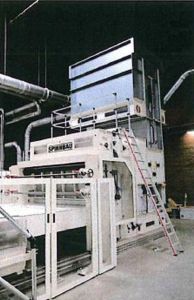 SPINNBAU CARDING LINE, YEAR 2013REFERENCE NUMBER: T-6848 SPINNBAU CARDING LINE, YEAR 2013 BRAND: SPINNBAU SHORT DESCRIPTION: CARDING LINE YEAR: 2013 INSTALLED 2014 LIKE NEW, LITTLE RUN TIME 4 HOPPER TEMAFA BLEND LINE, 1600mm WIDE, 1 WITH CONDENSER FED FROM TRIM MACHINE CARDING WILLOW – 800mm WIDE FEED BELT AND 1200mm WIDE – TEMAFA TEMAFA MIXMASTER BLENDING BIN – 3000mm WIDE X 8000mm LONG X 4600mm HIGH (FILL HEIGHT 3000mm). 72 CUBIC METER CAPACITY. TEMAFA FINE OPENER – 2000mm WIDE WITH PINS 3000mm SPINNBAU CARD FEEDING UNIT – FEED TRUNK, VIBRATING CHUTE, WEIGHT BELT 708mm BREAST SECTION WITH 3 WORKERS AND STRIPPERS, 1500mm MAIN WITH 5 W/S AND (2) 708mm DOFFERS. 1 FOUNDATIONS AND PLATFORMS. DILO PROFILINE – BATT WEIGHT CONTROL SYSTEM MAHLO WEIGHT MEASURING UNIT – QUALISCAN CMS-12 DILO LAYER CROSSLAPPER – TYPE DLS 30/60 – 3000mm INFEED AND UP TO 6000mm LAYDOWN. MAX WEB HEIGHT 650mm. MAXIMUM SPEED 125M/MIN. SPINNBAU LAP DRAFTER TYPE VST 19 – MAX 6000mm WORKING WIDTH. 9 ROLLER PAIRS. LIFTING DEVICE TO ALLOW FOR 600mm CLEARANCE. 159mm ROLLER DIAMETER. INFEED HEIGHT 650 mm BRUCKNER THERMOBONDING OVEN – 5000mm OVEN WITH 3 HEATING AND 2 COOLING ZONE. MAGNETIC BELT. 3 NATURAL GAS MAXON BURNER. SLITTING – 9 POSITION BRUCKNER CRUSH CUTTER SLITTING HEADS. PNEUMATIC LIFTING. 450mm KNIFE DIAMETER CROSS CUTTER – ROTARY CUTTER STYLE WITH CLAMPING. CAPABLE OF 3 CUTS/MINUTES FOR MATERIALS UP TO 200mm THICK. WINDING – ASCENDING BATCH STYLE WINDER. MAX ROLL DIAMETER OF 1200mm. 3000mm DRIVEN FEED CONVEYOR. MANDREL GUIDANCE SYSTEM, MANUALLY ADJUSTABLE BRAKE SYSTEM FOR CONTROLLING TENSILE FORCE AND COMPACTION. TEMAFA FILTER HOUSE – TFS 50. MAX FLOW 50,000 CUBIC METER/H ELECTRICL INFO – 3 X 480V/60Hz. CONTROLS 110V AC/24 DC. SIEMENS PLC QUANTITY: 1 Learn More
SPINNBAU CARDING LINE, YEAR 2013REFERENCE NUMBER: T-6848 SPINNBAU CARDING LINE, YEAR 2013 BRAND: SPINNBAU SHORT DESCRIPTION: CARDING LINE YEAR: 2013 INSTALLED 2014 LIKE NEW, LITTLE RUN TIME 4 HOPPER TEMAFA BLEND LINE, 1600mm WIDE, 1 WITH CONDENSER FED FROM TRIM MACHINE CARDING WILLOW – 800mm WIDE FEED BELT AND 1200mm WIDE – TEMAFA TEMAFA MIXMASTER BLENDING BIN – 3000mm WIDE X 8000mm LONG X 4600mm HIGH (FILL HEIGHT 3000mm). 72 CUBIC METER CAPACITY. TEMAFA FINE OPENER – 2000mm WIDE WITH PINS 3000mm SPINNBAU CARD FEEDING UNIT – FEED TRUNK, VIBRATING CHUTE, WEIGHT BELT 708mm BREAST SECTION WITH 3 WORKERS AND STRIPPERS, 1500mm MAIN WITH 5 W/S AND (2) 708mm DOFFERS. 1 FOUNDATIONS AND PLATFORMS. DILO PROFILINE – BATT WEIGHT CONTROL SYSTEM MAHLO WEIGHT MEASURING UNIT – QUALISCAN CMS-12 DILO LAYER CROSSLAPPER – TYPE DLS 30/60 – 3000mm INFEED AND UP TO 6000mm LAYDOWN. MAX WEB HEIGHT 650mm. MAXIMUM SPEED 125M/MIN. SPINNBAU LAP DRAFTER TYPE VST 19 – MAX 6000mm WORKING WIDTH. 9 ROLLER PAIRS. LIFTING DEVICE TO ALLOW FOR 600mm CLEARANCE. 159mm ROLLER DIAMETER. INFEED HEIGHT 650 mm BRUCKNER THERMOBONDING OVEN – 5000mm OVEN WITH 3 HEATING AND 2 COOLING ZONE. MAGNETIC BELT. 3 NATURAL GAS MAXON BURNER. SLITTING – 9 POSITION BRUCKNER CRUSH CUTTER SLITTING HEADS. PNEUMATIC LIFTING. 450mm KNIFE DIAMETER CROSS CUTTER – ROTARY CUTTER STYLE WITH CLAMPING. CAPABLE OF 3 CUTS/MINUTES FOR MATERIALS UP TO 200mm THICK. WINDING – ASCENDING BATCH STYLE WINDER. MAX ROLL DIAMETER OF 1200mm. 3000mm DRIVEN FEED CONVEYOR. MANDREL GUIDANCE SYSTEM, MANUALLY ADJUSTABLE BRAKE SYSTEM FOR CONTROLLING TENSILE FORCE AND COMPACTION. TEMAFA FILTER HOUSE – TFS 50. MAX FLOW 50,000 CUBIC METER/H ELECTRICL INFO – 3 X 480V/60Hz. CONTROLS 110V AC/24 DC. SIEMENS PLC QUANTITY: 1 Learn More -
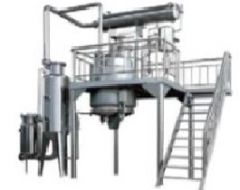 MULTI FUNCTION EXTRACTING TANKREFERENCE NUMBER: P-8842 MULTI FUNCTION EXTRACTING TANK APPLICATION: IT IS USED FOR EXTRACTING, CONCENTRATING, SOLVENT RECOVERY AND AROMATIC OIL COLLECTION FOR MEDICINAL HERB AND MANY PLANTS. FEATURES: IT INCLUDES EXTRACTING TANK, SINGLE-EFFECT EXTERNAL CIRCULATION CONCENTRATOR TOGETHER WITH OTHER AUXILIARY EQUIPMENT. IT HAS COMBINING EXACTING, CONDENSATION, SOLVENT RECOVERY FUNCTION WITH FEATURES OF COMPACT STRUCTURE AND EASY OPERATION. QUANTITY: 1 Learn More
MULTI FUNCTION EXTRACTING TANKREFERENCE NUMBER: P-8842 MULTI FUNCTION EXTRACTING TANK APPLICATION: IT IS USED FOR EXTRACTING, CONCENTRATING, SOLVENT RECOVERY AND AROMATIC OIL COLLECTION FOR MEDICINAL HERB AND MANY PLANTS. FEATURES: IT INCLUDES EXTRACTING TANK, SINGLE-EFFECT EXTERNAL CIRCULATION CONCENTRATOR TOGETHER WITH OTHER AUXILIARY EQUIPMENT. IT HAS COMBINING EXACTING, CONDENSATION, SOLVENT RECOVERY FUNCTION WITH FEATURES OF COMPACT STRUCTURE AND EASY OPERATION. QUANTITY: 1 Learn More -
 T-6543 MEDICAL UNIVERSAL TENSILE TESTING EQUIPMENT
T-6543 MEDICAL UNIVERSAL TENSILE TESTING EQUIPMENTREFERENCE NUMBER: T-6543
MEDICAL UNIVERSAL TENSILE TESTING EQUIPMENT
SHANDONG INDEPENDENTLY RESEARCH AND DEVELOPMENT THIS COMPREHENSIVE TESTING MACHINE FOR SURGICAL MASK & PROTECTIVE CLOTHING, IT IS WIDELY USED IN A VARIETY OF MASK STRENGTH DETECTION PROJECTS.FEATURES:COMPLY WITH NATIONAL STANDARDS, MEDICAL STANDARDS TESTING REQUIREMENTS, AUTOMATIC SOFTWARE CONTROL SYSTEM, MEET THE REQUIREMENTS OF DATA STORAGE, PRINTING, COMPARISON. THE IMPORTED SERVO MOTOR IS EQUIPPED WITH PRECISION SCREW DRIVE SYSTEM TO ENSURE THE STABILITY OF TEST DATA.
TEST STANDARDS:
GB 19082-2009 TECHNICAL REQUIREMENTS FOR DISPOSABLE PROTECTIVE CLOTHING FOR MEDICAL USE (4.5 BREAKING STRENGTH -THE BREAKING STRENGTH OF MATERIALS IN KEY PARTS OF PROTECTIVE CLOTHING SHOULD NOT BE LESS THAN 45N)
(4.6 ELONGATION AT BREAK -THE ELONGATION AT BREAK OF KEY PARTS OF PROTECTIVE CLOTHING SHOULD NOT BE LESS THAN 15%)
SELF-PRIMING FILTER RESPIRATOR FOR RESPIRATORY PROTECTION ARTICLES5.6.2 BREATHING BONNET -BREATHING BONNET SHALL BE SUBJECT TO AXIAL TENSION"DISPOSABLE MASK: 10N FOR 10S" "REPLACEABLE MASK: 50N FOR 10S"
(5.9 HEADBAND -HEADBAND SHOULD BEAR THE TENSION "DISPOSABLE MASK: 10N, 10S" "REPLACEABLE HALF MASK: 50N FOR 10S" "FULL MASK: 150N FOR 10S")
5.10 JOINTS AND CONNECTING PARTS -JOINTS AND CONNECTING PARTS SHALL BE SUBJECT TO AXIAL TENSION
"REPLACEABLE HALF MASK: 50N FOR 10S" "FULL COVER 250N FOR 10S"
GB/T 32610-2016 TECHNICAL SPECIFICATION FOR DAILY PROTECTIVE MASKS
(6.9 BREAKING STRENGTH OF THE MASK BELT AND THE CONNECTION BETWEEN THE MASK BELT ANDTHE MASK BODY ≥ 20N)
(6.10 FASTNESS TO BREATHING BONNET: NO SLIPPAGE, BREAKAGE OR DEFORMATION SHALL OCCUR)
YY/T 0699-2013 DISPOSABLE SURGICAL MASK
(4.4 MASK BELT -THE BREAKING FORCE AT THE CONNECTION POINT BETWEEN EACH MASK BELT AND THE MASK BODY IS NOT LESS THAN 10N)
YY 0469-2011 SURGICAL MASK FOR MEDICAL USE (5.4.2 MASK BELT)
GB/T 3923.1-1997 DETERMINATION OF BREAKING STRENGTH AND ELONGATION AT BREAK OF FABRICS (STRIP METHOD)
DISPOSABLE RUBBER INSPECTION GLOVES (6.3 TENSILE PROPERTIES)
INSTRUMENT TECHNICAL PARAMETERS:
SPECIFICATION: 200N (STANDARD) 50N, 100N, 500N, 1000N (OPTIONAL)
ACCURACY: BETTER THAN 0.5RESOLUTION OF FORCE VALUE: 0.1N
DEFORMATION RESOLUTION: 0.001mm
TEST SPEED: 0.01mm/MIN ~ 2000mm/MIN (STEPLESS SPEED REGULATION)
WIDTH OF SAMPLE: 30mm (STANDARD FIXTURE) 50mm (OPTIONAL FIXTURE)
CLAMPING OF SAMPLES: MANUAL (PNEUMATIC CLAMPING CAN BE CHANGED)
STROKE: 700mm (STANDARD) 400mm, 1000mm (OPTIONAL)
QUANTITY: 1
Learn More -
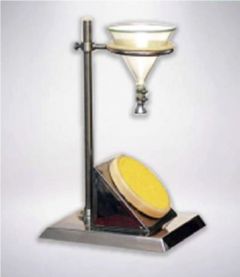 T-6548 FABRIC SURFACE WETTING TESTER
T-6548 FABRIC SURFACE WETTING TESTERREFERENCE NUMBER: T-6548
FABRIC SURFACE WETTING TESTER
INSTRUMENT TECHNICAL DESCRIPTION:
WATER TESTER IS TO INSTALL THE SAMPLE ON THE SAMPLE HOLDER AND MAKE AN ANGLE OF 45 ° WITH THE LEVEL. THE CENTER OF THE SAMPLE IS LOCATED AT A SPECIFIED DISTANCE BELOW THE NOZZLE. THE SAMPLE IS SPRAYED WITH A SPECIFIED VOLUME OF DISTILLED OR DEIONIZED WATER. BY COMPARING THE APPEARANCE OF THE SAMPLE WITH THE EVALUATION STANDARDS AND PICTURES TO DETERMINE ITS WATER-SOAKING GRADE, IT IS SUITABLE FOR MEASURING VARIOUS WATER-SOAKING TESTS ON THE SURFACE OF FABRICS WITH OR WITHOUT WATER RESISTANCE AND WATER REPELLENT FINISHING. THIS INSTRUMENT IS NOT SUITABLE FOR MEASURING THE WATER PERMEABILITY OF FABRICS, SO IT CANNOT BE USED TO PREDICT THE RAINPROOF PERMEABILITY OF FABRICS.
STANDARD:
GB19082-2009 TECHNICAL REQUIREMENTS FOR MEDICAL PRIMARY PROTECTIVE CLOTHINGGB / T4745 SURFACE MOISTURE RESISTANCE TEST
THE MAIN TECHNICAL INDICATORS OF THE INSTRUMENT:
GLASS FUNNEL: φ150mm
MEASURING CUP: 500ML
SAMPLE SUPPORT ANGLE: 45 °
INSTRUMENT CONFIGURATION:
1. ONE HOST
2. A GLASS FUNNEL
3. 500ML MEASURING CUP
QUANTITY: 1
Learn More -
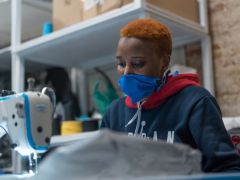 D-2388 What’s the Best Material for a Mask?
D-2388 What’s the Best Material for a Mask?Federal health officials have now recommended that we cover our faces with fabric during the coronavirus pandemic. But what material offers the most protection?
The Centers for Disease Control and Prevention has posted a no-sew mask pattern using a bandanna and a coffee filter as well as a video on making masks using rubber bands and folded fabrics found at home.
While a simple face covering can reduce the spread of coronavirus by blocking outgoing germs from coughs or sneezes of an infected person, experts say there is more variation in how much homemade masks might protect the wearer from incoming germs, depending on the fit and quality of the material used.
Scientists around the country have taken it upon themselves to identify everyday materials that do a better job of filtering microscopic particles. In recent tests, HEPA furnace filters scored well, as did vacuum cleaner bags, layers of 600-count pillowcases and fabric similar to flannel pajamas. Stacked coffee filters had medium scores. Scarves and bandanna material had the lowest scores, but still captured a small percentage of particles.
If you don’t have any of the materials that were tested, a simple light test can help you decide whether a fabric is a good candidate for a mask.
“Hold it up to a bright light,” said Dr. Scott Segal, chairman of anesthesiology at Wake Forest Baptist Health who recently studied homemade masks. “If light passes really easily through the fibers and you can almost see the fibers, it’s not a good fabric. If it’s a denser weave of thicker material and light doesn’t pass through it as much, that’s the material you want to use.”
Researchers say it’s important to remember that lab studies are conducted under perfect conditions with no leaks or gaps in the mask, but the test methods give us a way to compare materials. And while the degree of filtration for some homemade masks seems low, most of us — who are staying home and practicing social distancing in public — don’t need the high level of protection required for medical workers. More important, any face covering is better than none, especially if worn by a person who has the virus but doesn’t know it.
The biggest challenge of choosing a homemade mask material is to find a fabric that is dense enough to capture viral particles, but breathable enough that we can actually wear it. Some items being touted online promise high filtration scores, but the material would be unwearable.
Dressing Up for Work … at Home
Yang Wang, an assistant professor of environmental engineering at Missouri University of Science and Technology, worked with his graduate students to study various combinations of layered materials — including both air filters and fabric. “You need something that is efficient for removing particles, but you also need to breathe,” said Dr. Wang, who last fall won an international award for aerosol research.To test everyday materials, scientists are using methods similar to those used to test medical masks, which everybody agrees should be saved for medical workers who are exposed to high doses of virus from seeing infected patients. The best medical mask — called the N95 respirator — filters out at least 95 percent of particles as small as 0.3 microns. By comparison, a typical surgical mask — made using a rectangular piece of pleated fabric with elastic ear loops — has a filtration efficiency ranging from 60 to 80 percent.
Dr. Wang’s group tested two types of air filters. An allergy-reduction HVAC filter worked the best, capturing 89 percent of particles with one layer and 94 percent with two layers. A furnace filter captured 75 percent with two layers, but required six layers to achieve 95 percent. To find a filter similar to those tested, look for a minimum efficiency reporting value (MERV) rating of 12 or higher or a microparticle performance rating of 1900 or higher.
The problem with air filters is that they potentially could shed small fibers that would be risky to inhale. So if you want to use a filter, you need to sandwich the filter between two layers of cotton fabric. Dr. Wang said one of his grad students made his own mask by following the instructions in the C.D.C. video, but adding several layers of filter material inside a bandanna.
Dr. Wang’s group also found that when certain common fabrics were used, two layers offered far less protection than four layers. A 600 thread count pillow case captured just 22 percent of particles when doubled, but four layers captured nearly 60 percent. A thick woolen yarn scarf filtered 21 percent of particles in two layers, and 48.8 percent in four layers. A 100 percent cotton bandanna did the worst, capturing only 18.2 percent when doubled, and just 19.5 percent in four layers.
The group also tested Brew Rite and Natural Brew basket-style coffee filters, which, when stacked in three layers, showed 40 to 50 percent filtration efficiency — but they were less breathable than other options.
If you are lucky enough to know a quilter, ask them to make you a mask. Tests performed at the Wake Forest Institute for Regenerative Medicine in Winston-Salem, N.C., showed good results for homemade masks using quilting fabric. Dr. Segal, of Wake Forest Baptist Health, who led the study, noted that quilters tend to use high-quality, high-thread count cotton. The best homemade masks in his study were as good as surgical masks or slightly better, testing in the range of 70 to 79 percent filtration. Homemade masks that used flimsier fabric tested as low as 1 percent filtration, Dr. Segal said.
The best-performing designs were a mask constructed of two layers of high-quality, heavyweight “quilter’s cotton,” a two-layer mask made with thick batik fabric, and a double-layer mask with an inner layer of flannel and outer layer of cotton.
Bonnie Browning, executive show director for the American Quilter’s Society, said that quilters prefer tightly woven cottons and batik fabrics that stand up over time. Ms. Browning said most sewing machines can handle only two layers of fabric when making a pleated mask, but someone who wanted four layers of protection could wear two masks at a time.
Ms. Browning said she recently reached out to quilters on Facebook and heard from 71 people who have made a combined total of nearly 15,000 masks. “We quilters are very much in the thick of what’s going on with this,” said Ms. Browning, who lives in Paducah, Ky. “One thing most of us have is a stash of fabric.”
People who don’t sew could try a folded origami mask, created by Jiangmei Wu, assistant professor of interior design at Indiana University. Ms. Wu, who is known for her breathtaking folded artwork, said she began designing a folded mask out of a medical and building material called Tyvek, as well as vacuum bags, after her brother in Hong Kong, where mask wearing is common, suggested it. (DuPont, the maker of Tyvek, said in a statement that Tyvek is intended for medical apparel, not masks.) The folded mask pattern is free online, as is a video demonstrating the folding process. In tests at Missouri University and University of Virginia, scientists found that vacuum bags removed between 60 percent and 87 percent of particles. But some brands of vacuum bags may contain fiberglass or are harder to breathe through than other materials, and shouldn’t be used. Ms. Wu used a bag by EnviroCare Technologies, which has said it does not use fiberglass in its paper and synthetic cloth bags.
“I wanted to create an alternative for people who don’t sew,” said Ms. Wu, who said she is talking to various groups to find other materials that will be effective in a folded mask. “Given the shortage of all kinds of materials, even vacuum bags might run out.”
The scientists who conducted the tests used a standard of 0.3 microns because that is the measure used by the National Institute for Occupational Safety and Health for medical masks.
Linsey Marr, a Virginia Tech aerosol scientist and an expert in the transmission of viruses, said the certification method for respirators and HEPA filters focuses on 0.3 microns because particles around that size are the hardest to catch. While it seems counterintuitive, particles smaller than 0.1 microns are actually easier to catch because they have a lot of random motion that makes them bump into the filter fibers, she said.
“Even though coronavirus is around 0.1 microns, it floats around in a wide range of sizes, from around 0.2 to several hundred microns, because people shed the virus in respiratory fluid droplets that also contain lots of salts and proteins and other things,” said Dr. Marr. “Even if the water in the droplets fully evaporates, there’s still a lot of salt and proteins and other gunk that stays behind as solid or gel-like material. I think 0.3 microns is still useful for guidance because the minimum filtration efficiency will be somewhere around this size, and it’s what NIOSH uses.”
Learn More -
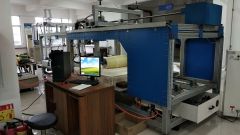 L-7136 MATTRESS DURABILITY COMPREHENSIVE TESTER
L-7136 MATTRESS DURABILITY COMPREHENSIVE TESTERABLE TO DO ROLLING TESTS ON MATTRESSES
DURABILITY TEST FOR THE BED SURFACE:
1. USES INDEPENDENT CONTROL SYSTEM. PLC CONTROL SEPARATELY. COOPERATE WITH COLOR TOUCH SCREEN. IT IS
CONVENIENT AND VISUAL TO OPERATE. THE TESTING PROCESS AND THE RUNNING STATUS BE CLEAR TO US, TEST TIMES CAN
BE SET FREELY.
2. SPECIAL LIFT DEVICE IS CONVENIENT TO LIFT UP THE HEAVY ROLLER AND EASY TO MOVE IT TO THE TEST AREA OF THE
MATTRESS. THEN PUT DOWN THE ROLLER AND MAKE ITS OWN WEIGHT FULLY LOAD TO THE SURFACE OF THE MATTRESS.
3.ROLLER CAN MOVE UP AND DOWN IN THE TESTING PROCESS, TO ADAPT TO CONCAVE AND CONVEX SURFACE OF THE
MATTRESS.
4. WHEN DOING DURABILITY TEST OF EDGE, ROLLER CAN BE MOVED TO THE “PARKING” AREA BEHIND THE INSTRUMENT.
5. DURABILITY TEST FOR THE EDGE IS DRIVEN BY SERVO MOTOR; IT IS QUIET, STEADY AND RELIABLE TO OPERATE.
6. INCORPORATES ADVANCED PHOTOELECTRIC SENSE TECHNOLOGY. THE BEGINNING POSITION OF THE CENTER LINE OF THE
CUSHION SURFACE RETURN TO THE HOME POSITION AUTOMATICALLY.
DURABILITY TEST FOR BED EDGE :
ADOPT INDEPENDENT CONTROL SYSTEM, USING DEDICATED HIGH-PRECISION AND HIGH INTELLIGENT ARAM CONTROLLER
AND SPECIAL TEST SOFTWARE. IT CAN RUN UNDER WINDOWS SYSTEM ON PC, IT IS OPERATED ALL BY SOFTWARE, THE
INTERFACE OF SOFTWARE IS EASY TO OPERATE.
SPECIAL TEST SOFTWARE ON PC, WINDOWS OPERATING PAGE, A HIGH DEGREE OF COMPATIBILITY.
TEST PROGRAM HAS ALREADY BEEN SET ON THE SOFTWARE ON PC ACCORDING TO THE TEST REQUIREMENT. A KEY TO TEST.
IT IS CONVENIENT FOR OPERATOR TO LEARN AND SAVE THE TRAINING TIME.
THE CURVE WINDOW OF TEST SOFTWARE DISPLAY THE VALUES OF FORCE AND SHIFT IN REAL TIME, COORDINATE MODEL.
LOADING CUSHION ON THE EDGE AND LOADING CUSHION WHICH IS USED FOR MEASURING USE GENERIC CONNECTION
HEAD THAT CAN BE IN INTERCHANGED. SHARING A SET OF DRIVING DEVICE, SAVE SPACE AND COST.
ADJUSTABLE RACK. THE PRESSURE PLATE CAN BE ADJUSTED THE POSITION ALONG THE DIRECTION OF X AND Y. IT CAN
MEASURE EACH POINT OF THE MATTRESS. IT IS DIFFERENT FROM THE TRADITION WAY TO SEPARATE. THE TEST CAN BE
FINISHED WITHOUT MOVING THE SAMPLE.
SAVE A LOT OF TESTING TIME, GREATLY REDUCES THE WORKING INTENSITY, OPERATORS CAN ACHIEVE SINGLE OPERATION,
SAVE THE COMPANY COST.
FORCE SENSOR AVOIDS DAMAGE TO THE CORE COMPONENTS BECAUSE IT CAN MAKE PROTECTION WHEN IT IS OVERLOAD.ROLLING TEST SPEED: 16±2CYCLES PER MINUTE (OR SPECIFIED BY CUSTOMER)
Learn More
CYLINDER ROLLER: 1400N, THE MIDDLE DIAMETER: 300mm, BOTH ENDS DIAMETER: 250mm, LENGTH: 1000
HEXAGON STYLE WOODEN ROLLER: SIZE AS STANDARD REQUIREMENT
COUNTER: 0~999999 CAN BE SET.
THE CONTROL WAY OF ROLLING: TOUCH SCREEN + PLC CONTROL
LOADING CUSHION ON THE EDGE: BUTTOCKS SHAPE, 380mm X 495mm
LOADING PARTS ON THE EDGE: THE MIDPOINT ON THE LONG EDGE OF THE MATTRESS.200 mm FROM EDGE.
LOADING FORCE ON THE EDGE: 1000N
LOADING TIME ON THE EDGE: 3S
POSITION OF MEASUREMENT: MATTRESS CENTER, LEFT AND RIGHT ARE BOTH 250mm, THE MIDPOINT ON THE LONG EDGE
OF THE MATTRESS 200 mm INWARD.
LOADING PLATE OF MEASUREMENT: DIAMETER 355mm, RADIUS OF CURVATURE OF THE END R800mm
CAPACITY OF FORCE SENSOR: 2KN
LOADING SPEED OF MEASUREMENT: 90±5mm/MIN
STROKE: 500mm
DRIVE MOTOR: SERVO MOTOR -
 How To Choose an N95 Respirator Mask For Coronavirus Prevention? All You Need to Know Before Buying Face Masks
How To Choose an N95 Respirator Mask For Coronavirus Prevention? All You Need to Know Before Buying Face MasksHow To Choose an N95 Respirator Mask For Coronavirus Prevention? All You Need to Know Before Buying Face Masks.
1. What’s an N95 mask?
An N95 respirator is a respiratory protective face mask, designed to help reduce the user’s exposure to airborne particles including very small particles (0.3 microns) and large droplets. N95 respirator face mask literally has a filtration efficiency of at least 95% against non-oily particles.
2. Differences between N95 mask and surgical mask?
Generally, the N95mask also includes an N95 surgical mask. So, here we will just compare a standard N95 particulate mask with a disposable surgical mask. Surgical masks are designed to be worn by healthcare professionals during surgery and nursing, to help prevent contamination of the surgical field or the patient by capturing liquid droplets that are expelled by the user.
An N95 particulate mask blocks at least 95 percent of very small (0.3 microns) test particles, and while a disposable surgical mask is fluid-resistant and protects the user against large particles (5 microns), droplets, sprays or splatter.
Different from a loose-fitting, disposable surgical mask, an N5 mask is tight-fitting to achieve a very close facial fit, which guarantees a minimal leakage around the edges of the mask when the user inhales. If properly fitted, the filtration capabilities of N95 respirators exceed those of disposable surgical face masks.Speaking of the N95 mask price and disposable surgical mask price, the N95 respirator mask is pricier than a surgical mask. In contrast, the N95 mask is reusable but the common surgical mask is disposable. Strictly speaking, N95 respirator masks should be worn for a maximum of eight hours while the disposable surgical mask is recommended to be replaced every four hours.
However, during the novel coronavirus outbreak, face masks are in short supply and everyone discards one or two face masks every day. A surgical mask could be used for a whole day in a good condition of no damage, no moisture, and no deformation. According to some researches, the N95 respirator mask used for two days still maintains a filtration efficiency of at least 95%, while the filtration efficiency of an N95 respirator used for three days reduced to 94.7%. So, if an N95 respirator is in good maintenance, you can wear it for at least 2 days, a week, maybe even a month.
3. Types of N95 mask
Generally, according to their intended use, the types of N95 masks include the standard N95 particulate respirators and N95 surgical respirator masks. Additionally, there are N95 masks with a breathing valve or not.
1) Differences between standard N95 particulate respirator and N95 surgical mask:
How to differentiate standard N95 particulate-filtering respirators and N95 surgical masks? The N95 surgical mask is literally a combination of N95 respirator and surgical mask, it is both certificated by NIOSH as an N95 respirator and also cleared by the FDA as a surgical mask. N95 surgical respirator masks are also referred to as medical respirators, healthcare respirators, or surgical N95s.
The significant difference between a standard N95 particulate respirator and an N95 surgical mask is that the N95 surgical mask is fluid-resistant while the standard N95 particulate respirator is not.
An N95 particulate respirator, also called N95 dust mask or N95 pollution mask, helps reduce very small particles inhaled by the user, and it is used for respiratory protection when the user might be exposed to particulate hazards. With a fluid resistance plus, an N95 surgical mask help reduce particles both inhaled and exhaled by the user, it is designed to be used during surgery and nursing tasks, whatever the user requires respiratory protection, expelled particulates or requires fluid resistance.
2) Differences between N95 masks with a breathing valve or not:
Many people question: Is an N95 mask with an exhalation valve better than the one without a valve?
In fact, the N95 respirators with an exhalation valve are not recommended to be used for coronavirus prevention, because the valve is a one-way vent that couldn’t keep your exhalation to yourself. It means that this valved N95 mask makes your breathing out easier and helps reduce heat build-up to avoid fogging up your glasses, however, it’s not that friendly to others.
Besides, the N95 mask with the valve is pricier than the one without a valve.4. What are the differences between N95, KN95, FFP2, and KF94?
When you search for the N95 respirators, there are many respirators such as KN95, FFP2, and KF94 that appeared in the same breath. What’s different between these respirators of different letters?
Actually, both the N95, KN95, FFP2 and KF94 respirators have almost the same filtration efficiency, it means that KN95, FFP2, and KF94 are as effective as the N95 respirator mask. The main difference between these respirators is that they are tested by different nations.
The N95 mask has a full name of NIOSH-certified N95 respirator, which means these respirators are tested of 95% filtration and certified by the U.S. National Institute of Occupational Safety and Health (NIOSH). The KN95 respirator is a particulate-filtering mask tested using the China criteria. The FFP2 is a filtering facepiece score of 94% filter capacity approved by Europe, and the KF94 is tested by Korea criteria.
To simply put, we could put these respirators into an equation as below:
N100 (99.97%) = FFP3 (99.95%) > N95 (95%) = KN95 (95%) = FFP2 (94%) = KF94 (94%) > KN90 (90%).
Learn More
Anti Virus Flu Mask Meets FFP2 N95 KN95 KF94 Guidance
